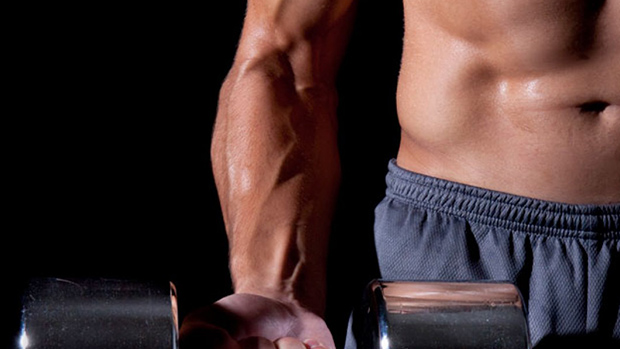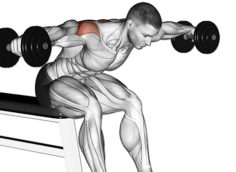Anatomy of the Rep
Most strength training programs are based on only one thing: reps. How often have you heard "ya gotta do 1 to 5 reps for strength and 8 to 12 reps for size" and other such pearls of wisdom from Michelin Man Joe, the self-appointed expert at your gym? If you're anything like me, you've heard it a bazillion times!
The problem I've always had with this type of thinking is that the way you complete the reps is just as important as the number of reps! Doing ten reps at a very fast tempo will have a much different training effect than doing ten reps using a slow, controlled rhythm. I've seen a lot of people training mostly in the 8 to 12 reps range who didn't gain an ounce of muscle tissue in three years! The problem was, their sets of 8 to 12 reps lasted about the length of their average sexual experience: five or ten seconds!
Many of these problems were solved when the concept of Time Under Tension (TUT) came into play. TUT quickly became a buzzword in the strength training kingdom. Along with tempo, TUT improved the quality of the training process, at least as far as hypertrophy (size) training was concerned.
These concepts helped gym enthusiasts around the world stimulate more muscle growth simply because they were now moving away from the 5 to 10 second sets onto more productive hypertrophy protocols. It also gave the average trainee more choices. As long as each set would last 40 to 70 seconds, you'd stimulate a lot of hypertrophy gains.
However, TUT itself had some problems. For one thing, it's a system (if you can call it that) that's highly unpractical for most athletes, mostly because it revolves around slow, controlled reps. These are great for hypertrophy, but not so great when power is concerned. Athletes need to train fast at least 30 to 40% of the time to gain the most from their training.
TUT and tempo training are also not very well suited for maximum strength lifting. Who in his right frame of mind would use tempo (counting rep speed) when attempting near-maximal and maximal weights? Not only is it unproductive to do so, it's dangerous!
Furthermore, as the weight gets heavy, it becomes harder and harder to maintain a certain lifting speed. At some point you just push against the damn thing hoping it'll rise up! Tempo is probably the last thing on your mind at this point!
This is part of the reason why TUT and tempo training have fallen out of favour among strength athletes around the world. However, I don't think we should throw out the baby with the bath water! There's a form of TUT training that's highly effective and applicable for athletes: timed sets.
What Are Timed Sets?
Timed sets are a form of TUT training without the tempo variable. The way it works is by selecting a certain timeframe which suits your needs and then doing as many reps as possible within that timeframe.
For example, if you're a hockey player, your shifts will last 30 to 45 seconds, so this is a very good timeframe to use. You'd simply try to complete as many reps as possible in 30 to 45 seconds. This allows you to work simultaneously on the specific energy system used in your sport while also targeting power.
Another benefit of this method is the development of functional hypertrophy over non-functional hypertrophy without having to resort to maximal weights. Some athletes indeed need more muscle mass; the problem is when they use classic bodybuilding training to achieve that goal, the mass they gain isn't entirely functional and there's little, if any, neural improvement.
A second alternative is to have the athlete complete a large number of heavy sets (80 to 95% of one rep max) with few reps. This is certainly more effective for an athlete since the mass gained will tend to be more functional and there'll be a significant neural improvement. However, this method can be potentially dangerous, especially if used by athletes without a proper base in strength training. Most of the time, athletes severely lacking in muscle mass won't do very well on this method of training.
In short, timed sets offer the best of both worlds! They allow you to stimulate muscle hypertrophy by using relatively long sets (40 to 70 seconds) and light loads, but doing as many lightning fast reps as possible (still making sure to respect proper form, of course). With this form of training you can significantly increase muscle mass while heavily involving the nervous system and improving the capacity to move quickly. Forget supersets; there are Superman sets! As a general form of athletic training, who could ask for more?
Obviously, timed sets are best suited to work on power, power-endurance, muscle-endurance, and functional hypertrophy. Their only weakness is when it comes to limit-strength development, so heavy lifting shouldn't be completely dropped. Both methods could easily be combined into a program to ensure complete development of the motor capacities.
Training Parameters
The beauty of timed sets is they allow for a lot of variation: the duration of each set can be modified to better develop a certain capacity. The only thing to remember is that each rep during the chosen timeframe should be explosive, or at least very fast. This means you're not going anywhere near failure.
Here's a short list of possible applications for this method and their general impact on your physical capacities:
1) Very Short Sets
Duration: 5-10 seconds
Load: 50-60%
Number of sets: 8-12
Maximal power development: very high
Hypertrophy development: low
Muscle and power endurance development: low
2) Short Sets
Duration: 10-20 seconds
Load: 40-50%
Number of sets: 6-10
Maximal power development: very high
Hypertrophy development: moderate
Muscle and power endurance development: low
3) Moderate Sets
Duration: 20-40 seconds
Load: 30-40%
Number of sets: 4-8
Maximal power development: high
Hypertrophy development: high
Muscle and power endurance development: moderate
4) Long Sets
Duration: 40-60 seconds
Load: 20-30%
Number of sets: 3-6
Maximal power development: moderate
Hypertrophy development: high
Muscle and power endurance development: high
5) Very Long Sets
Duration: 60-90 seconds
Load: 10-20%
Number of sets: 2-3
Maximal power development: low
Hypertrophy development: low
Muscle and power endurance development: high
Now the trick is to select the method(s) best suited to your sport. The info below should help you get started:
XXX = extremely effective method
XX = very effective method
X = effective method
If the duration of time isn't listed, the method isn't very effective for that sport.
Football
Very short sets: XXX
Short sets: XX
Moderate sets: X
Hockey
Long sets: XXX
Moderate sets: XX
Very long sets: X
Baseball
Very short sets: XXX
Soccer
Very long sets: XXX
Long sets: X
100-200m
Short sets: XXX
Very short sets: XX
Moderate sets: X
400-800m
Long sets: XXX
Moderate sets: XX
Very long sets: XX
Martial Arts
Very short sets: XXX
Throws
Very short sets: XXX
Bodybuilding
Moderate sets: XXX
Long sets: XX
Progression
Much like Coach Staley's EDT, your goal is to increase the number of reps you can complete within the set timeframe.
Once you've added a significant number of reps to each set, you can increase the load. Be patient; the objective is to do the reps faster. Progress in load only if you don't have to decrease speed too much. The ideal number of reps should be:
• Very short and short sets: 1.5 reps per second
• Moderate sets: 1 to 1.25 rep(s) per second
• Long and very long sets: 0.75 to 1 rep per second
If you can reach these threshold values, you can increase the load.
Conclusion
Timed sets have a lot to offer athletes and bodybuilders. They'll allow you to develop physical capacities directly applicable to your sport while being gentle on your body (which can be important to athletes involved in contact sports).
Also, this method can be used year round without risking overtraining. It's an interesting tool to add to your toolbox, and if power is important to you, you should definitely use it in your arsenal!




